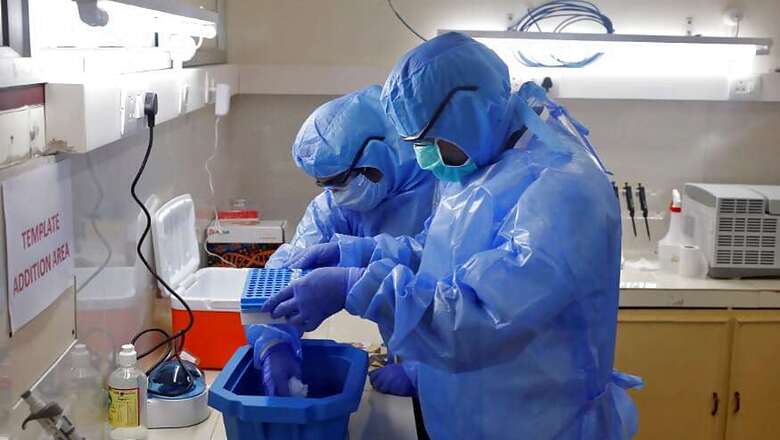
views
The government devised an "intelligent testing strategy" and scaled up its preparedness to fight the COVID-19 pandemic, taking lessons from the 2009 swine flu outbreak that had "exposed glaring gaps" in the country's diagnosis infrastructure, the ICMR said on Monday.
The apex health research body said to cater to the increasing need for testing, India developed an "intelligent testing strategy to remain ahead of the virus" by significantly shoring up its diagnosis infrastructure.
The country now has 610 laboratories - 432 public and 178 private which are currently testing 1.1 lakh samples daily. The testing capacity has been increased to 1.4 lakh samples per day, which is being further raised to 2 lakh, it said.
Keeping in view the revised understanding of the virus and the research work being done in India and elsewhere, testing criteria was widened to include returnees from abroad, migrant labourers and COVID-19 frontline workers.
Most states have been working with the National Tuberculosis Elimination Program (NTEP) to deploy TrueNAT machines for COVID-19 testing. Through this machine, testing is done in such areas/ districts where modern virological laboratory in private or public doesn't exist, the Indian Council of Medical Research (ICMR) said.
"Due to this, the testing infrastructure is not overwhelmed in any state to date. No state has a significant backlog of samples to be tested. More labs are being set up and additional machines are deployed in states like Uttar Pradesh, Bihar, West Bengal as well as in the rest of the country to meet the possible higher requirement," it said.
"A decade ago, when India witnessed one of the worst flu pandemics -- swine flu in 2009 -- the public health system was paralyzed due to severe dearth of infrastructure for molecular diagnosis of viral infections... public health professionals helplessly watched the pandemic quickly escalating to all parts of the country," the ICMR said.
Though the country was equipped to carry out serology-based ELISA or rapid blood tests, the virus was challenging and could not be detected in blood.
Molecular virological test was the only option for detection of H1N1 and it was available only in two institutions -- National Institute of Virology (NIV), Pune, and National Centre for Disease Control (NCDC), Delhi, it said.
"The event was an eye-opener for the public health system of the country wherein glaring gaps in testing capacity were brought out," the health research body said adding that this, in turn, paved the way for strengthening molecular diagnostic facilities for viruses in India through the Virus Research & Diagnostic Laboratory (VRDL) Network.
"Contrary to 2009, in January 2020, when the threat of COVID19 epidemic knocked at our doors, the government could immediately scale up its preparedness by standardizing diagnostic assays at ICMR NIV, Pune, and immediately commissioning diagnostic facility in 13 VRDLs based on their location in cities with International airports."
It said that COVID-19 being an imported infection, the labs were mapped based on their presence in cities where flights from China and other countries with reported coronavirus infections would land.
The government took a number of steps including the difficult decision of lockdown to slow down the spread of the virus and prepare healthcare infrastructure "to trace, track, test, quarantine, treat and save precious lives of people", the ICMR said.
With the country lacking adequate testing facilities in every district, it adopted an "intelligent testing strategy" to trace and track the virus and anticipate areas where testing would be required and all possible institutions both in the public or private like laboratories, universities and private medical colleges were identified.
AIIMS-like institutions were roped in, to handhold these institutions especially private medical colleges and private labs while lab technicians were trained to handle the sample and carry out tests with accuracy.
Supply of testing kits was ensured and Indian companies were helped to develop and scale up indigenous production of testing kits while ensuring they adhered to the quality and standards.
The government has been always sensitive not only to the present requirement but also about future needs of testing both of its scale and regions. All such areas were mapped which are under-served and suitable strategy developed, the ICMR said.
This led to developing COVID-19 molecular diagnostic capacity in 'difficult to reach' areas like Arunachal Pradesh, Nagaland, Sikkim, Ladakh, Goa, Andaman and Nicobar Islands among other, it said, adding that from 13 laboratories in the first week of February and 123 laboratories on March 24, India now has 610 COVID-19 testing labs.
Taking cognizance of the expected surge in cases due to influx of migrant workers in states such as Uttar Pradesh, Bihar, West Bengal and Odisha, the ICMR has proactively followed up these states to expand testing.




















Comments
0 comment